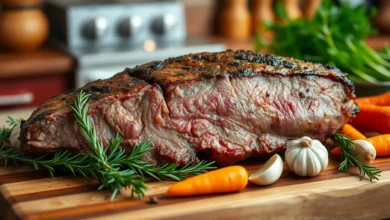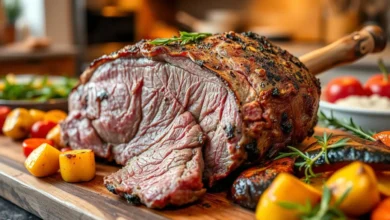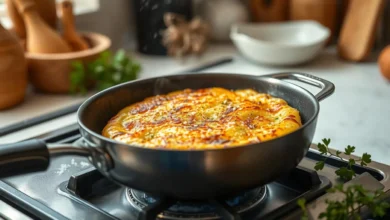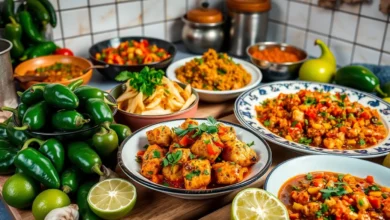Scotch Bonnet vs Habanero: Hot Pepper Showdown
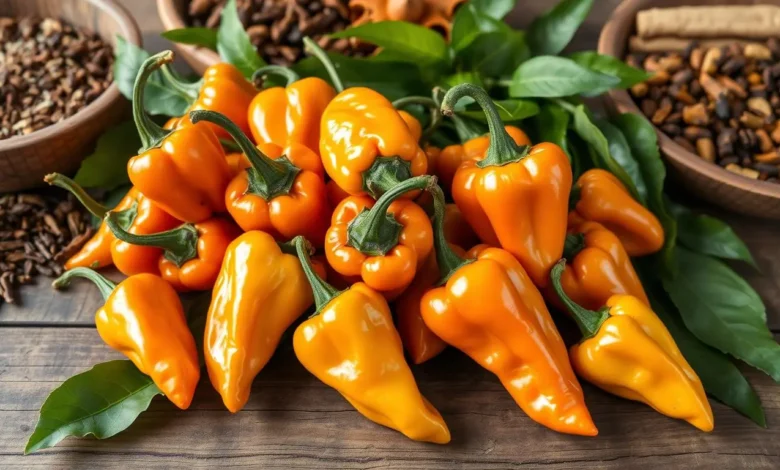
If you love spicy food, you’ve probably tried Scotch Bonnet and Habanero peppers. These peppers are famous in many cuisines for their unique heat and taste. We’ll explore the world of these peppers, looking at their origins, traits, and what makes them special.
Understanding Hot Pepper Heat Scales
The Scoville scale is the top way to measure pepper heat. It uses the Scoville Heat Unit (SHU) to show how spicy a pepper is. This method was created by Wilbur Scoville in 1912 and helps us compare pepper heat.
Scoville Heat Unit (SHU) Explained
The Scoville scale starts at 0 SHU for bell peppers, which are not spicy. The Carolina Reaper, the hottest pepper, has over 2 million SHU. So, the higher the SHU, the spicier the pepper.
Where These Peppers Rank on the Scale
| Pepper Variety | Scoville Heat Units (SHU) |
|---|---|
| Scotch Bonnet | 100,000 – 350,000 SHU |
| Habanero | 100,000 – 350,000 SHU |
Scotch Bonnet and Habanero peppers are very spicy. They both have high SHU ratings, making them among the spiciest peppers.
Heat Intensity Comparison Methods
The Scoville scale gives a number for pepper heat. But, how spicy a pepper feels can vary. This depends on personal taste, capsaicin sensitivity, and more.
Some people use other ways to compare pepper heat. The triangle taste test and just noticeable difference (JND) are examples. These methods involve tasting and analyzing to see how peppers compare.
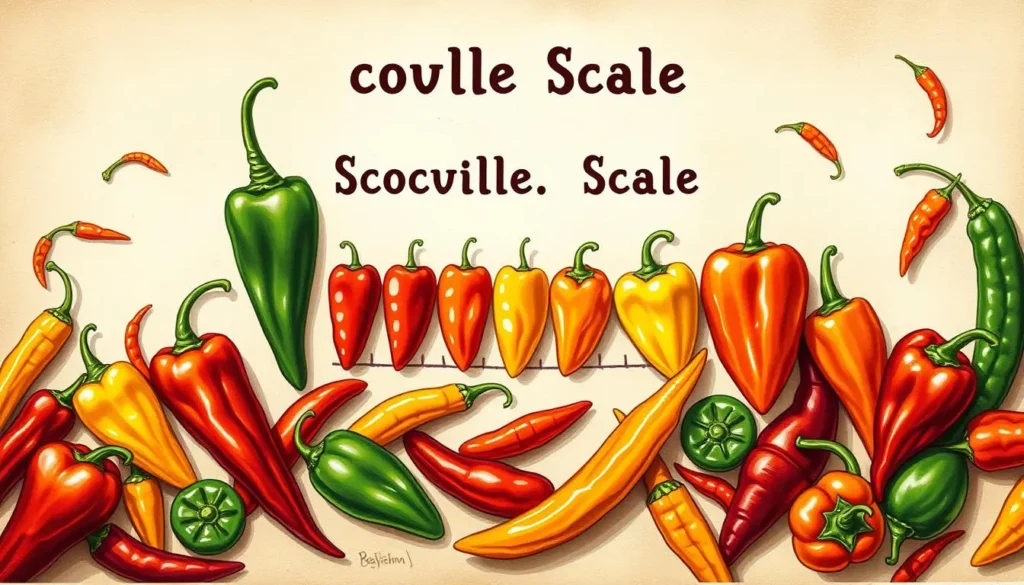
Origins and History of Scotch Bonnet Peppers
The Scotch Bonnet pepper is a key part of Caribbean cuisine. It comes from the warm climates of Jamaica and other islands. This pepper adds a unique flavor and heat to many dishes.
The name “Scotch Bonnet” might come from its look, like a Scottish hat. But it’s deeply rooted in Caribbean cooking, especially in Jamaican dishes.
In the Caribbean, the Scotch Bonnet is loved for its heat and flavor. It’s used in jerk meats, curries, and stews. This pepper is a must-have in Caribbean kitchens, adding to the area’s rich flavors.
| Pepper Variety | Scoville Heat Units (SHU) | Origin |
|---|---|---|
| Scotch Bonnet | 100,000 – 350,000 SHU | Jamaica, Caribbean |
| Habanero | 100,000 – 350,000 SHU | Yucatán, Mexico |
In Jamaican cuisine, the Scotch Bonnet is very important. It’s used in many traditional dishes like jerk chicken and curries. It’s also in spicy ginger beer.

The Scotch Bonnet has become famous worldwide. It’s loved for its unique taste and heat. Chefs and home cooks use it in many dishes, showing its lasting appeal.
Habanero Peppers: Mexican Heat Legacy
The habanero pepper is a true icon of Mexican cuisine, with a rich history in the Yucatan peninsula. These vibrant, fiery peppers are key to the region’s culinary traditions. They add their signature heat and flavor to many iconic dishes.
Cultural Significance in Yucatan
In the Yucatan, the habanero is highly valued for its role in local cuisine. It’s found in dishes like the smoky-sweet salsa habanero and the zesty cochinita pibil. These peppers are the heart of Yucatecan cooking. They symbolize the region’s rich culinary heritage.
Traditional Growing Regions
- The habanero pepper thrives in the Yucatan peninsula’s warm, tropical climate.
- Key areas include Tinum, Izamal, and Tizimín, where farmers have mastered habanero cultivation for generations.
- These regions produce some of the finest and most flavorful habanero peppers, known for their unique taste and heat.
Historical Usage
The habanero’s history in Mexican cuisine dates back centuries, with the Mayan people using them. These peppers were crucial in daily meals and rituals. After Spanish colonization, their popularity grew, becoming a cherished ingredient in Mexican cooking.
“The habanero is the beating heart of Yucatecan cuisine, infusing every dish with its fiery essence and unparalleled flavor.”
Physical Characteristics and Appearance
Scotch Bonnet and Habanero peppers look quite different. Knowing these differences helps you tell them apart easily.
The Scotch Bonnet has a Scotch Bonnet shape, often described as round or bell-shaped. It’s usually 2 to 3 inches long and 1 to 2 inches wide. They come in bright yellow, deep orange, and some have a reddish-orange hue.
The Habanero pepper is longer and lantern-shaped, with a pointed tip. They are 1 to 2.5 inches long and 1 to 1.5 inches wide. Their colors range from bright yellow to vibrant orange, with red and white varieties too.
Scotch Bonnets are rounded and have a broader base than Habaneros. Scotch Bonnets also have a wrinkled skin, while Habaneros have a smoother one.
| Characteristic | Scotch Bonnet | Habanero |
|---|---|---|
| Shape | Flattened, slightly wrinkled, round or bell-shaped | Elongated, lantern-shaped with a pointed tip |
| Size | 2 to 3 inches in length, 1 to 2 inches in width | 1 to 2.5 inches in length, 1 to 1.5 inches in width |
| Color | Bright yellow to deep orange, with some reddish-orange varieties | Bright yellow to vibrant orange, with some red and white varieties |
| Texture | Slightly wrinkled or dimpled skin | Smooth surface |
Knowing the differences between Scotch Bonnet and Habanero peppers is useful. It helps you pick the right pepper for cooking or gardening. Their unique shapes, sizes, and colors ensure you get the perfect pepper for your needs.
Scotch Bonnet vs Habanero: Direct Comparison
The Scotch Bonnet and Habanero are two fiery hot peppers loved by many. They belong to the same Capsicum chinense species. Yet, they have different heat levels and flavors, making them perfect for various dishes.
Heat Level Differences
The Scotch Bonnet has a Scoville heat range of 100,000 to 350,000 SHU. The Habanero is slightly hotter, with a similar range. But, the heat can change based on how the peppers grow and their individual traits.
Flavor Profile Variations
The Scotch Bonnet tastes sweet, fruity, and floral, with hints of citrus or tropical fruits. The Habanero, however, has a more intense, earthy, and smoky flavor with a hint of bitterness.
Culinary Applications
Scotch Bonnets are a key ingredient in Caribbean dishes, adding a vibrant kick to jerk chicken, curries, and hot sauces. Habaneros, meanwhile, are a favorite in Mexican and Tex-Mex cooking. They’re often used in salsas, marinades, and as a seasoning for meats and veggies.
| Characteristic | Scotch Bonnet | Habanero |
|---|---|---|
| Heat Level (SHU) | 100,000 – 350,000 | 100,000 – 350,000 |
| Flavor Profile | Sweet, fruity, floral | Intense, earthy, smoky |
| Culinary Uses | Caribbean cuisine | Mexican and Tex-Mex cuisine |
Whether you like the sweet Scotch Bonnet or the smoky Habanero, both add unique flavors to dishes. Knowing the differences between these peppers can help you choose the right one for your cooking. It opens up new possibilities in the kitchen.
Growing Requirements and Cultivation
To grow tasty Scotch Bonnet and Habanero peppers, you need to know their specific needs. These hot peppers love warm, sunny places and well-draining soil. It’s key to understand their unique needs for great pepper plant care and hot pepper gardening.
For growing Scotch Bonnets and Habaneros, the soil matters a lot. They do best in rich, slightly acidic soil with a pH of 6.0 to 7.0. A mix of compost and sand in your potting soil or garden bed is perfect.
- Give them full sun, at least 6-8 hours a day, for the best growth and pepper production.
- Water them often, keeping the soil moist but not too wet.
- Feed them a balanced, slow-release fertilizer every 4-6 weeks to keep them healthy and productive.
- Keep them safe from frost and cold, as Scotch Bonnets and Habaneros don’t like it cold.
Growing these fiery peppers can be a fun challenge. With the right pepper plant care and hot pepper gardening tips, you’ll get a big harvest of spicy Scotch Bonnets and Habaneros.
Culinary Uses and Popular Recipes
Scotch Bonnet and Habanero peppers are key ingredients in many dishes worldwide. They add a unique flavor and heat to Caribbean and Mexican foods. These peppers have won the hearts of food lovers everywhere.
Caribbean Cuisine Applications
In the Caribbean, Scotch Bonnet peppers are a must-have. They add a special flavor and heat to dishes. They’re used in jerk seasoning, giving meats and seafood a smoky, sweet, and spicy taste.
They’re also key in making Caribbean hot sauces. These sauces are used to flavor rice and peas, curries, and more.
Mexican Dish Preparations
Habanero peppers are a big deal in Mexican cooking, especially in the Yucatan. They add heat and a fruity taste to dishes. For example, they’re in salsa de habanero, a favorite Mexican sauce.
They’re also used in sauces like cochinita pibil and xni-pec. These sauces are known for their vibrant flavors.
Modern Fusion Recipes
Today, Scotch Bonnet and Habanero peppers are in new, exciting dishes. They’re in Caribbean-style burgers and Mexican-inspired pizzas. Chefs and home cooks love to mix these peppers with new flavors.
| Scotch Bonnet Recipes | Habanero Dishes |
|---|---|
| Jerk Chicken | Habanero Hot Sauce |
| Scotch Bonnet Hot Sauce | Cochinita Pibil |
| Caribbean Curried Shrimp | Habanero-Mango Salsa |
| Scotch Bonnet-Infused Burgers | Habanero-Lime Chicken Tacos |
“The heat of Scotch Bonnet and Habanero peppers adds a powerful punch to Caribbean and Mexican cuisines, elevating the flavors and creating unforgettable culinary experiences.”
Health Benefits and Nutritional Value
Scotch Bonnet and Habanero peppers are more than just spicy. They offer health benefits and a rich nutritional profile. The compound capsaicin in them is key. It’s what makes them hot and has many health perks.
Capsaicin can boost metabolism, reduce inflammation, and help with pain management. Hot peppers are also packed with vitamins A and C and antioxidants. These nutrients support your immune system and overall health.
| Nutrient | Scotch Bonnet Pepper | Habanero Pepper |
|---|---|---|
| Vitamin A | 7,673 IU | 9,223 IU |
| Vitamin C | 54.2 mg | 46.8 mg |
| Capsaicin | 100,000-350,000 SHU | 100,000-350,000 SHU |
Adding these peppers to your meals can be a fun way to get the health benefits of capsaicin. Whether you choose the Caribbean Scotch Bonnet or the Mexican Habanero, you’ll get a nutritional boost.
Storage and Preservation Methods
Storing and preserving your Scotch Bonnet and Habanero peppers right is key. This way, you can enjoy their bold flavors and heat for months. Whether you want to keep them fresh or explore drying and freezing, this guide helps.
Fresh Pepper Storage
To keep your preserving hot peppers fresh, store them in the fridge in a paper or mesh bag. This lets air circulate and prevents them from getting soggy. For storing Scotch Bonnets and Habanero preservation, use them within 1-2 weeks for the best taste and heat.
Drying Techniques
- Air Drying: Hang or lay your peppers in a dry, well-ventilated area out of direct sunlight. This traditional method can take 1-2 weeks to fully dry the peppers.
- Oven Drying: Spread the peppers on a baking sheet and dry in a preheated oven at the lowest setting (around 135°F) for 6-8 hours, flipping occasionally.
- Dehydrator: Use a food dehydrator set to 95-115°F and dry the peppers for 6-12 hours, depending on their size and thickness.
Freezing Options
Freezing is a great way to preserve hot peppers for a long time. First, wash and dry the peppers well. You can freeze them whole, sliced, or chopped. Place the peppers in a single layer on a baking sheet and freeze until solid, then transfer to an airtight container or freezer bag. Frozen Scotch Bonnets and Habaneros will keep their flavor and heat for up to 12 months.
| Storage Method | Shelf Life | Recommended Use |
|---|---|---|
| Refrigerator | 1-2 weeks | Maintaining freshness of whole peppers |
| Air Drying | 6 months to 1 year | Preserving whole or crushed peppers for seasoning and sauces |
| Oven Drying | 6 months to 1 year | Preserving whole or crushed peppers for seasoning and sauces |
| Dehydrator | 6 months to 1 year | Preserving whole or crushed peppers for seasoning and sauces |
| Freezing | Up to 12 months | Preserving whole, sliced, or chopped peppers for cooking and sauces |
By learning these hot pepper preservation methods, you can enjoy the flavors of your Scotch Bonnets and Habaneros even after the harvest season is over.
Handling Safety and Precautions
When working with hot peppers like Scotch Bonnets and Habaneros, safety is key. These peppers have a lot of capsaicin, which can irritate your skin and eyes. It’s important to handle them carefully.
Always wear gloves when you’re cutting or handling these peppers. This prevents capsaicin from getting on your skin. Also, avoid touching your face or sensitive areas. The capsaicin can cause a burning feeling.
Work in a place with good air flow. This helps avoid breathing in the pepper’s strong smell. It can irritate your lungs.
- Wear protective gloves to avoid direct skin contact.
- Wash your hands thoroughly with soap and water after handling the peppers.
- Avoid touching your eyes, nose, or mouth until you’ve thoroughly washed your hands.
- Work in a well-ventilated area to prevent inhalation of pepper fumes.
- Immediately wash any utensils, cutting boards, or surfaces that have come into contact with the peppers.
If you get a capsaicin burn, stay calm. The first thing to do is to rinse the area with cool water. If the burn doesn’t go away, see a doctor. Don’t rub the area, as it can make things worse. Keeping it cool and moisturized can help.
| Safety Measure | Purpose |
|---|---|
| Wear Gloves | Prevent direct skin contact with capsaicin |
| Wash Hands Thoroughly | Remove any residual capsaicin |
| Avoid Touching Face | Prevent irritation of eyes, nose, and mouth |
| Work in Ventilated Area | Minimize inhalation of pepper fumes |
| Clean Surfaces and Utensils | Eliminate cross-contamination |
By following these hot pepper safety tips, you can enjoy the bold flavors of Scotch Bonnets and Habaneros. You won’t have to worry about capsaicin burns or other pepper handling problems.
Commercial Production and Availability
In the hot pepper world, Scotch Bonnets and Habaneros stand out. Scotch Bonnets mainly grow in the Caribbean, with Jamaica and Barbados leading the way. Habaneros, however, are rooted in the Yucatan region of Mexico, where they’ve been grown for ages.
Want to buy Scotch Bonnets or Habaneros? You can find them in specialty stores and farmers’ markets across the U.S. They’re also showing up in regular supermarkets, especially where there are lots of Hispanics or Caribbean folks. Make sure to pick peppers that look fresh and have a shiny, smooth skin.
For a steady supply or more choices, online stores and specialty spice shops are great. They often have dried and powdered Scotch Bonnets and Habaneros. This is handy if you can’t find them locally. Just remember to buy from trusted sellers to get the best quality and freshness.
Delicious Scotch Bonnet Pepper Recipes You’ll Love
10 Spicy Scotch Bonnet Recipes to Heat Up Your Meals
onion and radishes cooked together
FAQ
What is the difference in heat level between Scotch Bonnet and Habanero peppers?
Both Scotch Bonnet and Habanero peppers are very hot. But Habaneros are a bit hotter, with a Scoville Heat Unit (SHU) range of 100,000 to 350,000. Scotch Bonnets also fall in this range. So, Habaneros are slightly more intense.
How do the flavor profiles of Scotch Bonnet and Habanero peppers differ?
Scotch Bonnets taste sweet and fruity, with floral notes. Habaneros have a more complex taste, with citrus and a smoky hint. Scotch Bonnets also have an earthy flavor, while Habaneros are tangy and vibrant.
What are the best culinary applications for Scotch Bonnet and Habanero peppers?
Scotch Bonnets are great in Caribbean and West African dishes, like jerk seasoning and hot sauces. Habaneros are key in Mexican cooking, used in salsas and marinades. Both add a fiery kick to modern recipes.
How can I safely handle and store Scotch Bonnet and Habanero peppers?
Wear gloves when handling these peppers to avoid eye and face irritation. Store them in the fridge for up to a week or freeze for longer. Drying is another way to keep them fresh longer.
Where can I purchase fresh or dried Scotch Bonnet and Habanero peppers?
You can find these peppers at grocery stores, specialty shops, and online. They grow in the Caribbean, Mexico, and other tropical areas. Check local farmers’ markets or international stores too.
